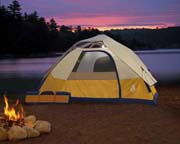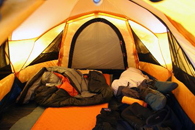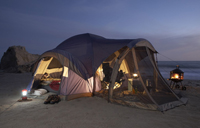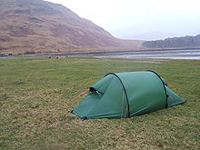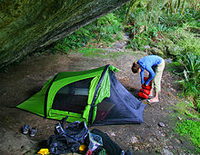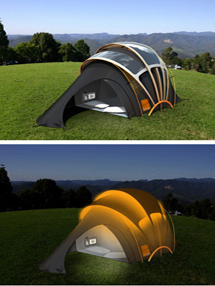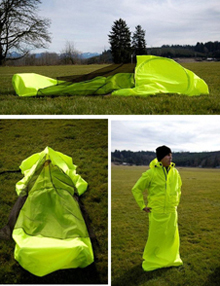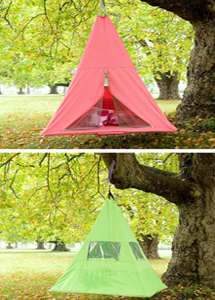
Tents are an important part of any outdoor event. When done properly with all the right equipment and knowledge about camping, it can be really fun and you will have a great time. Staying in a tent is a great way to be in the fresh air and still be comfortable.
| | The best camping tent for you depends on the amount of people that will be sleeping in it, the type of camping you will be doing and the where you will be camping. You want your tent to be able to keep you dry when it rains and have good ventilation on those hot steamy nights. Smaller tents may be free-standing or attached to the ground, large tents are usually anchored using guy ropes tied to stakes or tent pegs. |
Types
| Tents for recreational camping fall into two categories. |
| Tents intended to be carried by backpackers are the smallest and lightest type. Small tents may be sufficiently light that they can be carried for long distances on a touring bicycle, a boat, or when backpacking. The second type are larger, heavier tents which are usually carried in a car or other vehicle. Depending on tent size and the experience of the person or people involved, such tents can usually be assembled (pitched) in between 5 and 25 minutes. | |
| Some very specialised tents have spring-loaded poles and can be 'pitched' in seconds, but take somewhat longer to strike. |
Features of Camping Tents
When shopping for a new camping tent, look for features that will let you enjoy the use of that tent for many years to come.
How big should a tent be?
| If you're not planning to backpack or canoe camp, the size and weight of a tent doesn't matter so long as it fits in your vehicle. Tent capacity is based on the square footage and how many standard sleeping bags will fit in it. |
| | For example, a 2-person tent will accommodate just two people. There will be very little elbow room or extra storage space. You'll find a 4-person tent will be more comfortable for two people, and you will have space to spread out and store your gear too. For a family of four I recommend a 6-person tent. As a rule-of-thumb buy a tent that has a capacity rated two people higher than the number that will actually be using it. |
| You may want to check out the multi-room tents. If you're camping with the kids, a 2-room tent provides a little privacy. Multi-room tents come in 2-room styles, where the rooms are separated by an inside tent wall with a zippered door. There are 3-room styles that are like the 2-room ones but with an added screen room, which is nice for changing wet or dirty clothes before entering the other rooms, and which are great for setting up chairs or a table to use in case it rains. |
What tent features should I look for?
A tent with aluminum poles.
Tents may come with fiberglass poles, but they are fragile and more likely to break. If you bend or break a pole, most camping stores sell replacements or repair kits.
A tent with an adequate rainfly.
The rainfly is your tent's umbrella. The bigger the better. Look for a fly that comes well down the sides of the tent rather than just across the top. Rainflies are waterproof. Tent walls are water-repellant.
A tent with folded seams and double stitching.
If you can pull the material on either side of a seam and see through the stitches, this tent will leak. Be sure to use seam sealer on all seams.
»MORE
Modern Tent Styles
With modern materials, tent manufacturers have great freedom to vary types and styles and shapes of tents.
poles effectively hold the tent in the required shape.
which dismantle for ease of transport are either colour-coded or linked by chain or cord, so there is little doubt as to which poles connect where.
few guy ropes are needed (sometimes none).
exact positioning of any guy ropes is not too critical.
| Rigid poles Many tents which use rigid steel poles are free-standing and do not require guy ropes, though they may require pegs around the bottom edge of the fabric. These tents are usually so heavy (25 to 80 kg) that it takes a rather strong wind to blow them away. Flexible poles Flexible poles used for tents in this section are typically between 3 and 6 metres long (10 and 20 feet). Cheap poles are made of tubes of fibreglass with an external diameter less than 1 cm (1/3 inch), whereas more expensive aluminium alloys are the material of choice for added strength and durability. Inflatable airbeams Inflatable pole supports, also known as airbeams, serve as rigid structural supports when inflated but are soft and pliable when deflated. Tents using such technology are neither commonly used nor widely accepted and are available from a very limited number of suppliers. | |
Creative Camping Tents
| Orange Solar Tent Concept | Jacket + Tent + Sleeping Bag = JakPak | Treepee |
Tips To Prolong The Life Of Tent
1. Never store food in or around your tent, and never eat in your tent.
2. If your tent comes with a ground cloth, use it.
3. When you return from a camping trip. set your tent up in the yard and air it out. This will help prevent mold and mildew.
4. Do not store your tent in a stuff sack. Store it loosely in a dry ventilated area. Use the stuff sack to pack your tent when going to and from the campground.
Written by Nicolas Yang
